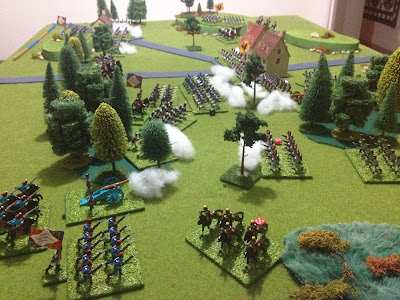A while back in August 2017 I listed all my painting projects. These are a combination of projects I wanted to do because of interest, or because I had a number of miniatures collected many years ago before I tool a break from wargaming. Producing this list was prompted by two blogs:
Natholeon's Empires and
Here's No Great Matter where there was a suggestion of a more project minded approach to painting armies.
Fortunately my projects are medium sized (I believe) due to the limitations of a 6x4 foot gaming table. There are only so many units which can be accommodated on such a sized table. This is a self imposed tabletop size, as it is easy to manoeuvre troops and I prefer games to be about an hour or so in duration.
Anyway, back on topic. I posted the list back in
August. Looking at the list today I can cross off the first two projects as being completed.
Napoleonic - Completed December 2017.
WW2 Burma - Completed October 2017.
Samurai - A very old collection of 25mm MINIFIGS which I am yet to start.
English Civil War - The plan is to repaint my old and partially painted Hinchcliffe 25mm miniatures. Yet to start.
Warhammer Age of Sigmar (starter pack) - Yet to start.
Warhammer 40K - Started work on Necromunda figures.
So which one to start on next? I exclude Warhammer 40K as this is my never ending project. One which I will often use as a filler or when I feel the need to do something different.
Before choosing the next project. There is one additional project which should be added to the list and is causing a dilemma for me - ACW (Spencer Smith miniatures). I have enough infantry, cavalry and artillery for a couple of armies, but I already have some painted Minifigs 15mm ACW armies. Rather than have two ACW armies in different scales. My present thinking is to create a couple of Victorian Science Fiction armies using these Spencer Smith ACW miniatures with various scratch built contraptions. Most likely they will be painted with a ACW theme along with walking Ironclads perhaps?
Currently my focus is on playing out my solo French Indian War campaign and devising rules for some Napoleonic games. Here are some photos of a recent Napoleonic game using some quickly produced house rules, which are an amalgamation of ideas from OHW and 2 by 2 napoleonic rules.
 |
| Opening moves of a game which is loosely based on the battle of Wertingen1805 |
 |
| French Guard attack supported by Light Infantry |
 |
| The battle hots up with French cavalry attacking the Austrian right flank |
 |
| Austrian cavalry rush to protect their left flank |
 |
| Austrian Infantry in a square defending against the French cavalry |
 |
| Artillery is used to break the Austrian Infantry square - after which Austrian forces retire |






















































